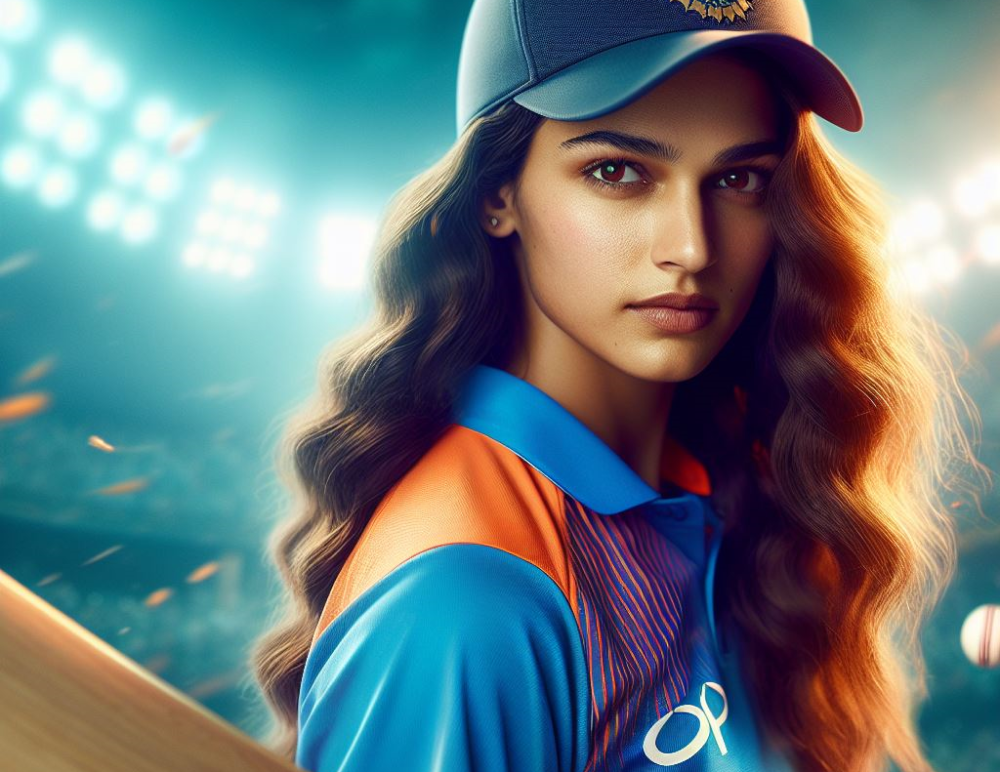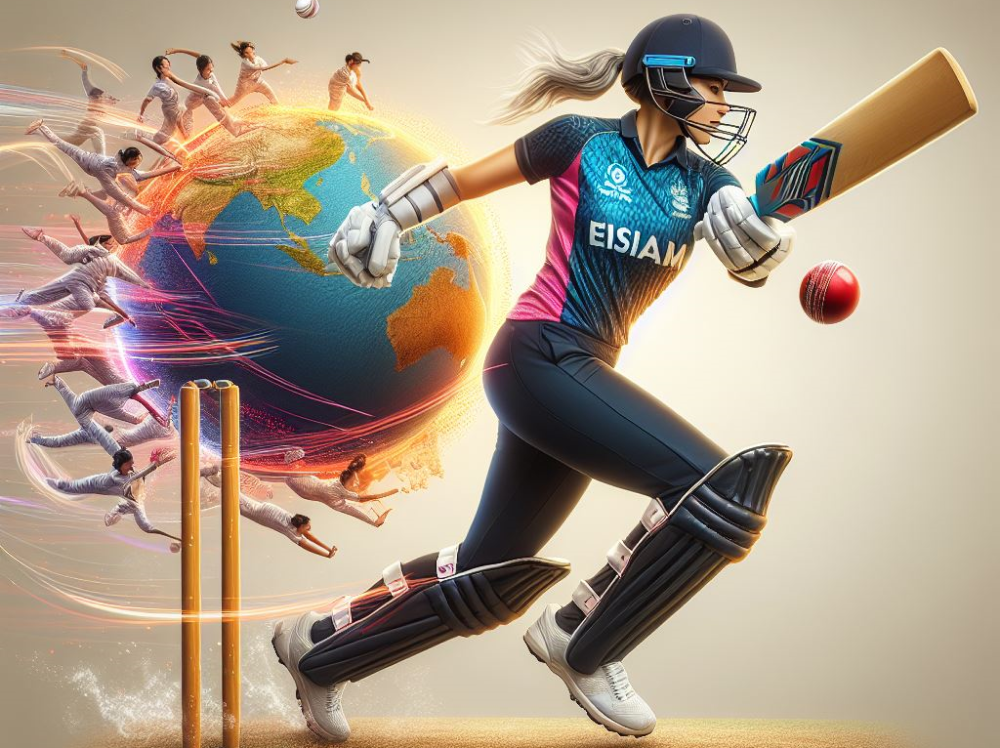
Women’s Cricket and The Fight Against Sexism
Women’s cricket and the fight against sexism has been an ongoing battle for years, swinging hard to knock ingrained prejudices out of the park. It’s a game where the players don’t just run between the wickets; they run against stereotypes and for equality.
Every boundary scored by a woman in cricket isn’t just a notch on the scoreboard; it’s a strike in the fight against sexism. It’s a fight that has seen remarkable innings, from dusty fields to international stadiums, pushing for a level playing field where a woman’s cover drive is celebrated as much as a man’s.
Cricket, like many other sports, has evolved. The history of cricket is not just about the changing shape of bats or the colors of the team jerseys. It’s about changing attitudes and recognizing that passion for the game isn’t gendered.
The history and evolution of cricket reflect a timeline where women have steadily batted their way to recognition, showing that they too can lead teams, break records, and enthrall audiences with their athleticism and strategy.
With eyes on the prize, women’s cricket has taken bold strides towards greater visibility and respect. The push to include women’s cricket in the Olympic Games is a leap towards global recognition, not just for the sport but for the athletes who are role models to girls who dream of donning their national caps.
The inclusion would mean more than just a medal; it would be a crowning achievement in the quest for gender equality in sports.
However, the journey starts much before the international arenas, in backyards and local grounds. It begins with the young girl who learns her first cricket skills and drills, not yet aware of the societal biases that she may face.
It’s in these grassroots efforts where the seeds of equality are sown, nurtured by coaches who teach not just the game, but the belief that cricket is for everyone.
As these young players grow, so do their skills. A carefully crafted cricket skills progression for different age groups ensures that the talent is refined and the love for the game deepens.
It’s a process that respects the journey of each player, recognizing the unique challenges and milestones they may face in a sport that’s learning to appreciate its female athletes.
Women’s cricket is more than a game. It’s a narrative of resilience, of breaking barriers, and of the sheer joy that comes from playing a sport that one loves.
It’s a narrative that continues to challenge the status quo, inspiring the next generation of girls to pick up a bat, put on the gloves, and play — not just for the runs, but for the respect and recognition they rightfully deserve.
The Rise of Women’s Cricket

In the world of cricket, female athletes have been steadily claiming their place on the field, smashing the barriers of sexism.
Join me as we explore the exhilarating journey of women’s cricket. From delving into its rich history to celebrating the remarkable contributions of notable women players, we’ll witness the rise of this game-changing sport.
Get ready to be inspired as we unravel the captivating story behind the rise of women’s cricket.
History of Women’s Cricket
The history of women’s cricket spans over a century, showcasing the rich history of this sport. Women’s cricket originated in the 18th century in England, with the first recorded match taking place in 1745. This early display of interest and passion among women set the stage for the development of the game.
As time went on, women’s cricket gained recognition and popularity in the late 19th century. A significant milestone occurred in 1887 when the White Heather Club, the first women’s cricket club, was formed in Yorkshire. This club provided a platform for women to showcase their skills and demonstrate their love for the game.
The development of women’s cricket was not without challenges. Women encountered resistance and prejudice, with some believing that cricket was a sport exclusively for men. Despite these barriers, determined women persevered and pursued their passion for the game.
A major moment in the history of women’s cricket took place in 1934 with the occurrence of the first international women’s cricket match. This match between England and Australia marked a significant step forward for the sport.
Since then, women’s cricket has continued to grow, with more countries actively participating and contributing to its development.
Today, women’s cricket is celebrated worldwide and has gained immense popularity. Prestigious tournaments like the Women’s Cricket World Cup attract a global audience, and female cricketers have become inspiring role models.
Women’s cricket has empowered countless women and has shattered societal stereotypes, encouraging young girls to pursue their dreams without limitations.
One remarkable example is Mithali Raj, the former captain of the Indian women’s cricket team. Born in 1982, she discovered her love for cricket at a young age and dreamt of representing her country. Despite facing challenges and a lack of support, Mithali became one of the greatest cricket players in women’s history.
Her extraordinary achievements include holding the record for the highest run-scorer in women’s international cricket.
Mithali’s journey symbolizes the resilience and determination of women in cricket. Her success has inspired numerous young girls to follow their dreams and strive for excellence in the sport. Mithali Raj’s story is a shining example of the rich history and promising future of women’s cricket.
Notable Women Players in Cricket
Several notable women cricketers have made significant contributions to the sport, paving the way for future generations. Here are some standout players:
1. Belinda Clark: She is considered one of the greatest women cricketers of all time. Clark held the record for the highest individual score in ODIs for 17 years, with 229* against Denmark in 1997. She also captained the Australian women’s cricket team to two World Cup victories in 1997 and 2005.
2. Mithali Raj: Raj is the highest run-scorer in women’s international cricket and the first female cricketer to surpass 6,000 runs in ODIs. She has been a consistent performer for the Indian women’s team and has led them to several successful campaigns.
3. Ellyse Perry: Perry is an Australian cricketer who has excelled in both batting and bowling. She is the only player, male or female, to have scored over 1,000 runs and taken more than 100 wickets in T20Is. Perry’s contributions have been pivotal to Australia’s success.
4. Charlotte Edwards: Edwards is a former English cricketer who captained the England women’s cricket team from 2005 to 2016. Under her leadership, England won the Ashes and the World Cup. Edwards was known for her stylish batting and exceptional leadership skills.
5. Meg Lanning: Lanning is an Australian cricketer known as one of the best batters in the world. She holds numerous records in women’s cricket, including being the youngest player to score 10 ODI centuries. Lanning has played a vital role in Australia’s recent dominant performances.
One inspiring true story is that of Harmanpreet Kaur, an Indian cricketer who gained prominence during the 2017 World Cup. In the semi-final match against Australia, Kaur played a magnificent innings, scoring an unbeaten 171 runs off just 115 balls.
Her performance led India to the final, where they narrowly lost to England. Kaur’s innings received widespread acclaim and showcased the talent of women cricketers. It also inspired many young girls in India to take up cricket and dream big, proving that they can achieve great things in the sport.
These notable women players have not only showcased their skills but have also inspired future generations and significantly contributed to the rise of women’s cricket worldwide.
Rise of Women’s Game
The rise of women’s cricket, also known as the Women’s Game, has experienced a significant surge in popularity and recognition. Several factors, including increased investment and support from cricket boards and sponsors, have played a crucial role in enhancing the quality of women’s cricket.
Consequently, this has attracted more attention from fans and media alike.
Notably, the success and achievements of eminent women players have not only served as a source of inspiration for young girls but have also provided strong role models for them to look up to.
The push for gender equality and inclusivity in sports has resulted in the establishment of dedicated women’s leagues, competitions, and tournaments.
This expanding landscape of women’s cricket is a testament to the hard work, talent, and dedication of the female players involved and significantly contributes to the overall development and promotion of women’s sports.
To ensure a promising future and ongoing success for women’s cricket, continued support and investment are imperative.
Challenges Faced by Women in Cricket

When it comes to women in cricket, they face a multitude of challenges that hinder their progress and success in the sport. From enduring sexism within the cricketing community to grappling with the gender pay gap, and dealing with prevalent misconceptions and prejudices, these obstacles can be disheartening.
In this section, we will explore the different facets of these challenges, shedding light on the realities that women in cricket confront on their journey to equality and recognition.
Sexism in Cricket
Sexism in cricket affects female players and the growth of women’s cricket. It manifests in unequal opportunities, lack of recognition, and discriminatory practices.
1. Female players face unequal opportunities compared to their male counterparts. They receive less media coverage, sponsorship deals, and access to professional leagues. This disparity hinders the development and visibility of women’s cricket.
2. The gender pay gap is another form of sexism in cricket. Female cricketers earn significantly less than male players, despite their equal dedication and skills. This pay gap undermines the value and recognition of women’s cricket.
3. Misconceptions and prejudices surrounding women’s cricket contribute to sexism in the sport. Women players are often underestimated and not taken seriously, their abilities and achievements undermined. This affects their confidence and prevents the growth and support for women’s cricket.
Addressing sexism in cricket is crucial for empowering female players and the future of the sport. Eliminating sexism should include equal opportunities, recognition, and support for women’s cricket at all levels.
This can involve establishing gender-neutral policies, providing equal financial incentives, and promoting inclusivity in selection processes.
By combating sexism in cricket, we can cultivate an environment that fosters gender equality and enables female players to thrive. Embracing diversity and breaking down gender barriers will enhance women’s well-being and contribute to the overall growth and success of cricket.
Gender Pay Gap in Cricket
The gender pay gap in cricket is a significant issue for female players. Gender Pay Gap in Cricket exists, with female cricketers earning significantly less than their male counterparts.
Disparities in salaries are apparent, as female cricketers receive lower match fees, central contracts, and endorsement deals compared to their male counterparts. The gender pay gap in cricket is partly due to the historical lack of investment and sponsorship opportunities for women’s cricket.
This, in turn, has an impact on the recognition and visibility of female cricketers, making it harder for them to be acknowledged and respected like male players.
The pay gap can act as a barrier to participation, discouraging talented female players from pursuing a career in cricket. This limits the talent pool and hinders the growth of women’s cricket.
To address the gender pay gap in cricket, cricket boards and sponsors must invest more in women’s cricket, provide equal opportunities for female players, and ensure fair compensation for their efforts and contributions to the sport.
Misconceptions and Prejudices
Misconceptions and prejudices often hinder the progress of women in cricket. It is crucial to acknowledge that women’s cricket is just as competitive and skillful as men’s cricket.
Women players consistently showcase exceptional talent, dedication, and hard work, which is evident in their outstanding performances on the field. They undergo rigorous training and face the same level of competition as their male counterparts.
One prevalent misconception is that women’s cricket is not as entertaining to watch. Women’s cricket possesses its own unique style of play, which is filled with excitement and thrilling moments. With the presence of star players and closely contested matches, it provides immense enjoyment for fans.
Prejudices further impede the growth of women’s cricket. Some individuals believe that women cannot excel in cricket at a high level or that the sport is unsuitable for them. These prejudiced notions create unnecessary barriers and limit opportunities for women in the field.
Nonetheless, despite these challenges, women’s cricket continues to thrive and shatter barriers. There is a growing recognition of the talent and hard work displayed by female cricketers, leading to increased support and opportunities for them.
It is essential to remember that women’s cricket has a rich and illustrious history that dates back to the 18th century.
One of the earliest recorded matches took place in Surrey, England, in 1745. Throughout the years, women’s cricket has steadily grown and evolved, with various organizations and tournaments promoting and developing the sport.
Today, women’s cricket is played at both domestic and international levels, with countries like England, Australia, and India leading the way. The achievements of female cricketers have paved the way for the rise of women’s cricket and have demonstrated the undeniable need for equal recognition and support.
Breaking Stereotypes
In the realm of women’s cricket, we find a powerful force breaking stereotypes and challenging sexism head-on. This section explores the triumphs and struggles of this movement. We uncover stories of empowering female players, delve into the concept of equality in cricket, and explore the creation of female-only spaces.
Join us as we unravel the fascinating journey towards redefining gender norms in the world of cricket.
Empowering Female Players
Empowering female players in cricket is crucial for promoting gender equality and providing opportunities for women to excel in the sport. Here are some ways to empower female players:
1. Equal opportunities: It is essential to ensure that female players have access to the same training facilities, coaching, and resources as their male counterparts.
2. Mentorship programs: Establish programs where experienced female players can guide and support younger players, helping them develop their skills and confidence.
3. Promoting visibility: Increase the visibility of female players by covering their performances in the media, broadcasting matches, and promoting women’s cricket tournaments.
4. Sponsorship and endorsements: Encourage sponsors and brands to invest in women’s cricket, providing financial support and endorsements to female players.
5. Training and skill development: Provide access to high-quality coaching and training programs that enhance the skills and capabilities of female players.
6. Creating safe spaces: It is crucial to establish a safe and inclusive environment for female players, free from discrimination, harassment, and sexism.
7. Recognition and rewards: Recognize the achievements and successes of female players through awards, incentives, and other forms of acknowledgment.
Pro-tip: Show support for women’s cricket by attending matches, purchasing merchandise, and spreading awareness about the achievements of female players. By doing so, you contribute to the empowerment and growth of women in the sport.
Equality in Cricket
Equality in cricket is paramount for ensuring fairness and inclusiveness in the sport. The progress that women’s cricket has made both on and off the field is significant.
To maintain equality, it is crucial for women to have equal opportunity in terms of access to training facilities, coaching, and competitions at all levels.
Additionally, female cricketers should receive fair and equal compensation, including prize money in tournaments and endorsements, in order to achieve pay parity.
Increasing the visibility of women’s cricket through greater media coverage and broadcasting of matches will provide the recognition and exposure it deserves.
Ensuring fair representation and decision-making authority for women in cricket governing bodies is vital for cricket governance. By doing so, we can shape the future of the sport.
Providing equal opportunities for girls to participate in cricket programs from grassroots development will help nurture talent from a young age.
It is through actively working towards equality in cricket that we can create an inclusive and diverse sporting environment which empowers female cricketers and inspires future generations of girls to participate.
Creating Female-Only Spaces
1. Establishing safe environments: Female-only spaces in cricket provide safe and comfortable environments for women to participate. They promote inclusivity, teamwork, and a sense of belonging among female players.
2. Encouraging participation: Female-only spaces motivate and boost women’s confidence to participate in cricket. These spaces offer opportunities for skill development, training sessions, and matches, allowing players to improve their performance.
3. Building networks and support systems: Female-only spaces serve as platforms for women to connect, form friendships, and build support systems. These networks provide mentorship, guidance, and camaraderie, enhancing the overall experience for female players.
4. Empowering women: Female-only spaces in cricket empower women to showcase their talents, gain recognition, and challenge societal stereotypes. By breaking barriers and proving their skills, female players inspire others to pursue their dreams and excel in the game.
5. Promoting gender equality: Creating female-only spaces in cricket addresses gender disparities within the sport. These spaces provide equal opportunities, resources, and facilities, contributing to gender equality and eliminating discrimination and bias against women.
Suggestions for creating female-only spaces in cricket:
1. Collaborate with cricket associations and clubs to establish dedicated training and playing facilities for women.
2. Organize women-only cricket tournaments and leagues to encourage participation and competition.
3. Provide access to female coaches and mentors who can guide and nurture talent.
4. Create online platforms and forums for women to connect, share experiences, and support each other.
5. Develop educational programs and workshops to address gender-related issues and promote inclusivity.
6. Encourage sponsorship and investment in women’s cricket, ensuring equitable financial support for players and teams.
By actively creating female-only spaces in cricket, we foster a diverse and inclusive sporting environment, empowering women and challenging gender biases within the game.
The Importance of Women’s Cricket

Women’s cricket is more than just a sport; it’s a powerful force that empowers women, inspires young girls, and promotes women’s sport. With every boundary hit and wicket taken, women’s cricket challenges sexism and paves the way for gender equality in the sporting world.
As more and more women step onto the field, breaking barriers and shattering stereotypes, the impact of women’s cricket goes far beyond the boundaries of the cricket pitch.
Empowering Women
Promoting Participation: Women’s cricket empowers women by encouraging their active involvement in a traditionally male-dominated sport. It provides a platform where women can pursue their passion for cricket and excel in a sport that celebrates their talents and abilities.
Breaking Stereotypes: Women’s cricket challenges societal stereotypes and prejudices. It demonstrates that women can be equally skilled and competitive athletes. By debunking gender-based misconceptions, women’s cricket cultivates confidence and self-belief in female players.
Inspiring Role Models: Women players in cricket inspire young girls to dream big and pursue their aspirations fearlessly. Female cricketers serve as role models, showing that with dedication, determination, and hard work, women can achieve success in any field.
Equality and Fairness: Women’s cricket highlights the importance of gender equality in sports. It promotes equal opportunities for female players in terms of training facilities, resources, and compensation. By advocating for fair treatment, women’s cricket enhances gender parity within the sport.
Social Transformation: Empowering women in cricket goes beyond the sport itself. It contributes to broader social change by challenging gender norms and empowering women in other areas of life. By promoting gender equality, women’s cricket aids in creating a more inclusive and equitable society.
Fact: The International Cricket Council (ICC) aims to increase the number of women participating in cricket to 1 billion by 2025, making it one of the fastest-growing sports for women globally.
Inspiring Young Girls
Women’s cricket has significantly inspired young girls to engage in the sport. Here are some key ways in which women’s cricket is inspiring young girls:
1. Representation: The increasing visibility of women’s cricket allows young girls to see themselves represented in the sport, inspiring them to pursue cricket.
2. Role models: Notable women players in cricket, like Mithali Raj and Ellyse Perry, serve as role models for young girls. Their achievements and dedication inspire young girls to believe in their own abilities and strive for success.
3. Breaking stereotypes: Women’s cricket challenges traditional gender roles and stereotypes, showing young girls that they can participate in any sport they choose. This empowers girls to pursue their sporting dreams.
To further inspire young girls in cricket, it is important to:
1. Provide access and opportunities: Schools and communities should offer cricket programs and facilities for young girls. This includes organizing tournaments, coaching sessions, and creating girls’ cricket teams.
2. Support and mentorship: Guidance from experienced female players greatly inspires young girls in their cricket journey. This can be achieved through workshops, training camps, and mentorship programs.
3. Celebrate achievements: Recognizing and celebrating the accomplishments of young girls in cricket fosters their passion and dedication. This can be done through awards, scholarships, and media coverage.
Promoting Women’s Sport
Promoting Women’s Sport is paramount in establishing a more inclusive and diverse sports sector. Here are some methods to actively advocate for women’s sport:
1. Enhance visibility: Offer equal opportunities for female athletes to demonstrate their talents and skills. Prioritise broadcasting and media coverage of women’s sports to raise awareness and attract more spectators.
2. Invest in grassroots initiatives: Encourage young girls to engage in sports from a young age by investing in grassroots programmes and projects. This will cultivate a strong foundation and pathway for female athletes, ensuring their continuous development and success.
3. Provide equal funding and resources: It is crucial to provide equal funding and resources for women’s sports. This includes investing in training facilities, coaching staff, and equipment. Bridging the funding gap between genders will create a level playing field, enabling female athletes to compete at their highest potential.
4. Challenge societal perceptions: Break down gender stereotypes and norms associated with specific sports. Promote the notion that women can excel in any sport they choose, encouraging more girls and women to participate. This will enhance overall participation and diversity in women’s sports.
Pro-tip: Supporting women’s sports not only fosters gender equality but also contributes to the overall development of society. By supporting and watching women’s sports, we can help establish a more inclusive and equal sporting culture.
The Future of Women’s Cricket

The future of women’s cricket holds a world of possibilities! From the growing popularity of the sport to the ongoing efforts in eliminating sexism, there’s a revolution taking place. With global events and increasing recognition, women’s cricket is making its mark on the world stage.
So, get ready to dive into the exciting journey of women’s cricket and explore the incredible strides being made towards inclusivity, empowerment, and a brighter future for this beloved sport.
Growing Popularity
The growing popularity of women’s cricket in the United Kingdom can be attributed to several key factors. One such factor is the increased visibility of the sport.
Nowadays, women’s cricket leagues and international tournaments are showcased on television and streamed online, giving fans worldwide the opportunity to watch the games and be part of the excitement. This heightened visibility has not only piqued interest but has also attracted new fans to the sport.
Another significant factor contributing to the surge in popularity is the emergence of exceptionally talented players. Figures like Ellyse Perry, Meg Lanning, and Harmanpreet Kaur have captured the attention of fans with their outstanding skills, inspiring young girls to take up cricket and follow in their footsteps.
Efforts to provide equal opportunities for women in cricket have also played a crucial role in driving the sport’s popularity. Cricket boards and sponsors have invested more in women’s cricket, resulting in increased resources, support, and infrastructure.
These initiatives have led to the growth of development programs, paving the way for aspiring players to nurture their talents.
There has been a noticeable shift in attitudes towards women’s cricket. The sport is now recognized for its talent and professionalism, with fans and media outlets treating it on equal footing with men’s cricket. This change in perception has further propelled the popularity of women’s cricket.
To continue the upward trajectory of women’s cricket, it is crucial to invest in grassroots development programs, leverage social media and other platforms to promote the sport, and provide more international opportunities. These efforts will ensure that women’s cricket reaches even greater heights in the future.
Eliminating Sexism in Cricket
Eliminating Sexism in Cricket is essential in the cricket community. Here are some strategies to address this issue and promote Gender Equality. It is important to advocate for equal opportunities and resources for men’s and women’s cricket, including equal pay, access to facilities, coaching, and media coverage.
Changing Mindsets is also crucial in challenging and changing sexist attitudes and stereotypes in the cricket community. This can be achieved through education and awareness campaigns.
Another effective strategy is to increase Representation of women in leadership roles in cricket such as umpires, coaches, and administrators.
This will ensure a diverse perspective in decision-making processes. Addressing Harassment is equally important and strict policies and procedures should be implemented to prevent and respond to instances of harassment and discrimination.
The cricket community should provide a safe and supportive environment with zero tolerance for sexism and abuse.
Media Coverage plays a vital role in challenging the notion of cricket as a male-dominated sport. Highlighting the achievements and stories of women cricketers can inspire young girls and provide role models for future generations.
By promoting and celebrating women’s accomplishments, we can break down societal barriers and inspire a new generation of female cricketers.
Eliminating sexism in cricket requires a collective effort from cricket organizations, players, fans, and media. Together, we can create a more inclusive and equal cricket community. A Pro-tip is to encourage young girls to participate in cricket and support women’s cricket teams.
By doing so, we can encourage and inspire a new generation of female cricketers.
Global Events and Recognition
Global Events and Recognition have played a significant role in advancing women’s cricket. They provide opportunities for female players to showcase their talents internationally.
1. World Cup: The ICC Women’s Cricket World Cup is the most prestigious global event in women’s cricket. It is held every four years and brings together teams from around the world to compete for the coveted title. The tournament promotes the sport and raises the profile of women’s cricket worldwide.
2. International Tours: These tours provide valuable exposure and allow players to compete against different teams in various countries. They promote women’s cricket internationally and foster camaraderie among nations. They also provide an opportunity for recognition and skill showcase.
3. Awards and Recognition: Recognising the achievements of female cricketers through awards such as the ICC Women’s Cricketer of the Year and ICC Women’s T20I Player of the Year promotes the sport and inspires young girls to take up cricket. These accolades highlight talent, dedication, and contribute to overall recognition in the cricketing world.
4. Media Coverage: Increased media coverage of women’s cricket, especially during global events, creates awareness and generates interest among fans. Extensive coverage, both through traditional media and digital platforms, ensures that the achievements and performances of female cricketers are visible to a wider audience.
5. Sponsorship and Investment: Global events and recognition attract sponsors and investments in women’s cricket, leading to better resources and infrastructure for the sport. This supports the development and growth of women’s cricket at various levels.
Global events and recognition provide a platform for female cricketers to excel and contribute to the growth and popularity of women’s cricket worldwide. Supporting and celebrating these events fosters gender equality and creates further opportunities for women in cricket.





